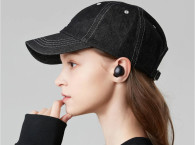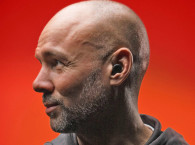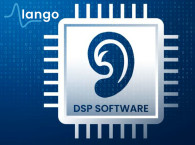The White House blog of August 2022 announcing the FDA’s release of the Over-the-Counter (OTC) hearing aid rule, which would take effect that October, highlighted the rationale for its creation: “Drive down costs, increase access, and open up a market space for creative innovation.” These were lofty goals, and there’s reason to believe they will in time be realized, but it is probably not an exaggeration to say that to date OTC hearing aids have had limited impact.

Low Adoption Rates and Potential Causes
A study published by the American Speech-Language-Hearing Association (ASHA) this September sums it up neatly: Just 2% of those with hearing difficulties purchased an OTC hearing aid, and only 4% of those with hearing difficulties stated an intent to purchase. ASHA concludes that “low likelihood to purchase is likely driven by a number of things,” then goes on to call out consumers’ lack of confidence that they could choose the correct device, or that it would be effective. Given the hundreds of models in the marketplace today, that is not surprising.

Leaving performance aside for the moment, there is an interesting conclusion to be drawn between cost and confidence. Consumer in-ear audio in general is a crowded space where brands that both perform well and break through the noise can earn premium prices and high sales volumes. Traditional audio brands in this position, such as Bose and Sony, are joined by newcomers with broader tech reputations such as Apple and Samsung. Consumers considering these brands are generally confident they will be satisfied with their purchase. Below the top 10 there are many niche players with less familiar brands and small shares of the market.
OTC hearing aids from recognizable brands with solid reputations are also positioned at the upper end of the market price range, although in this case the spread of prices is much higher with brands such as Jabra, Sony, Lexie (with Bose), and Sennheiser selling their devices in the range of $850 to $1,500. Buyers in the ASHA survey paid an average of $233 for OTC hearing aids, and those intending to buy estimate they would spend about $200. This is firmly in the “all others” category. Here is where the intersection of price and confidence come into play.
When a consumer is ready to spend around $200 for a TWS earbud goes shopping, they find brands they trust with reputations for good performance. But when they shop for OTC hearing aids in that price range, they find a plethora of names they never heard of, with sometimes questionable promotional material and mixed messages in the media about their benefit. Having already cleared the hurdle of recognizing their hearing loss and committing to find a solution, why aren’t the consumers surveyed by ASHA turning to the brands they know?
Competition from Above
Aside from the drag on sales due to the high prices themselves, OTC hearing aids from the recognized brands face competition from the lower end of the prescription market without offering unique benefits other than access or convenience. For people living a long distance from the nearest hearing care professional, increased access is not trivial. But for everyone else, one can get an in-person, professionally fitted, rechargeable prescription hearing aid with known performance from Costco for $1,500 — the upper end of the OTC range.
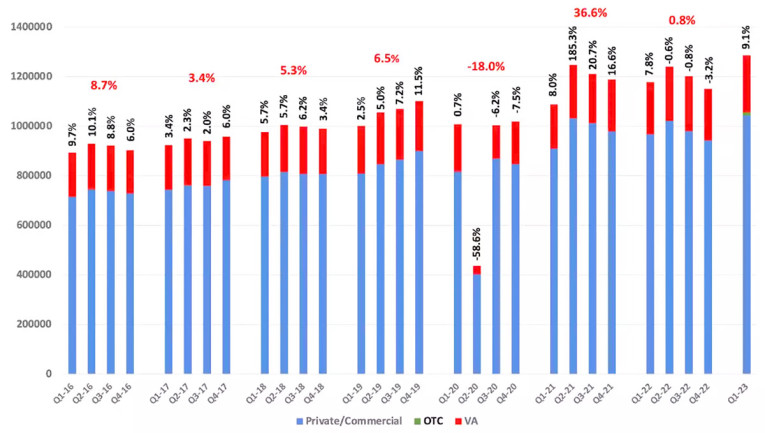
Are potential buyers of higher-end OTC devices actually going the prescription route? An intriguing data point comes from the trade group Hearing Industries Association (HIA) which collects and publishes hearing aid sales volume from the major manufacturers that comprise the backbone of their membership. The latest data publicly available shows a significant increase in US prescription shipments of 8% for Q1 2023 compared to the same quarter last year (9% including OTC, the first full quarter of OTC sales). Q1 growth is even higher, around 10%, compared to the previous quarter.
We will need to see a few more quarters to even speculate that all the publicity surrounding OTC and the comorbidities associated with untreated hearing loss is driving the increased adoption of prescription hearing aids. It would be a meaningful collateral benefit if it does.
Slow Start in Terms of Unit Sales
The ASHA survey illustrates the limited impact OTC hearing aids are having in terms of percentages. Unlike with prescription devices, finding actual sales figures for OTC is much harder. At the EUHA hearing industry exhibition earlier in October, Industry consultant Thomas Powers spoke to this in a presentation given together with Kate Carr, President of the HIA. Powers shared that "estimates of the OTC market range from 100,000 to one million units," and that "no organization is tracking sales, so it is difficult to get accurate numbers."
Interestingly, the HIA had itself included OTC sales in its quarterly reporting but seem to be backing away from doing so in recognition of the fact that only a small percentage of OTC sales are represented by HIA members.
Another way to ballpark sales is to combine the AHSA survey with a 2020 paper by Brent Edwards of the National Acoustic Laboratories (NAL), a well-respected research organization based in Australia. In it, Edwards derived from available data that there are about 28.7 million people who self-reported hearing difficulties but do not own hearing aids. This can be considered the total addressable market (TAM) for OTC, people who might buy a device for the first time based on self-assessment. Applying ASHA’s 2% ownership rate gives 574,000 units sold, with a little over 1 million more potential buyers on the fence. Allowing for the fact that the ASHA survey took place about 9 months after OTC availability, the number of units sold would be roughly 765,000 on an annual basis.
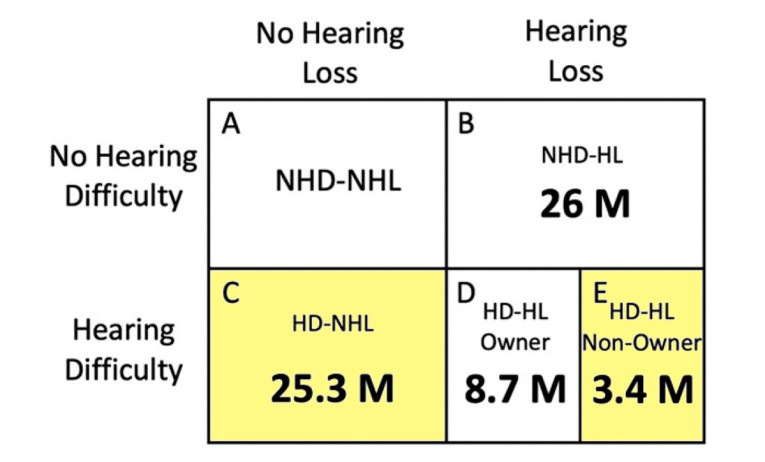
Delain Wright, working in business development for Intricon’s hearing solutions, puts sales at just over 1 million units. In conversing with Wright, it became clear that 1 million units (the upper end of Powers’ assessment and somewhat above the ASHA-NAL result) can be justified if one properly considers direct-to-consumer devices that were originally listed as traditional hearing aids but converted to OTC later on. But even that is less than 4% of the TAM if the NAL figures are accepted. This is meaningful for those who purchase and have good outcomes from OTC hearing aids but from an epidemiological point of view, the result is not impressive.
High Return Rates Reflect Immature OTC Industry
"Have good outcomes" is an important criterion. Only 46% of OTC owners in the ASHA survey reported being satisfied with their devices, although the number of people included, 37, is low enough that ASHA considers the result to be directional only. Even so, this is a very low rate of satisfaction by modern in-ear audio standards where AirPods Pro 2 and Samsung Galaxy Buds Pro have Amazon ratings of 4.6 and 4.5, respectively. It’s also in line with the Q2 2023 return rate of 34.2% reported by Eargo, a veteran player in the premium-priced direct-to-consumer hearing space.
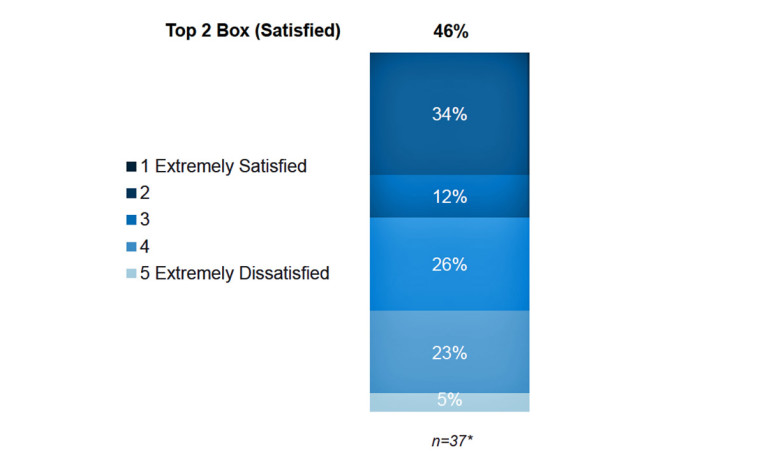
While in absolute terms the White House goal of driving down costs may have in part been achieved, it is a Pyrrhic victory when few people are using OTC hearing aids and half of those who do are not satisfied. Clearly, there is a lot of work to be done in the areas of pre-qualification, performance, and user experience. An aspect of pre-qualification is the large number of people (box C in the NAL chart) who report hearing difficulties but do not present with audiometric hearing loss. Hearing aid amplification by itself is less likely to be effective for this group, a topic I touched on for audioXpress in the January 2023 issue.
A Brighter Future on the Horizon
The other White House goals were to improve access and open the door to increased innovation. While access has certainly improved through online ordering, few are taking advantage of the opportunity. As for innovation, it is difficult to argue that we have seen anything interesting at all so far. Published test results show that higher-end devices generally perform well and provide the same functions as prescription hearing aids. Some of them are in fact rebranded devices that were once prescription hearing aids, or products using hearing aid chips and designed to emulate prescription hearing aids. While these may be in a good position to provide meaningful benefit to people with self-perceived hearing loss, they can hardly be considered innovative. The same can be said at the low end where some devices are built on the TWS earbud model and provide a more limited version of existing hearing aid functionality.
These are early days, so it is not surprising that the first OTC devices look a lot like what came before. Yet there are several reasons to believe that in the next year we will come closer to achieving all three White House goals. Innovation in chips is proceeding rapidly, especially in embedding increasingly powerful neural networks capable of running speech from noise separation algorithms or providing advance noise cancellation and occlusion reduction. These will be well-suited to situational devices worn primarily in challenging settings long before they can be included in all-day prescription hearing aids, also addressing the needs of people with little or no audiometric hearing loss but who experience hearing difficulty in noise.
There are also interesting developments in alternative form factors to attract buyers unwilling to wear traditional designs, some of which I have written about previously.
On the service side, several well-thought-out remote support systems are being introduced to onboard the new buyer, encourage hearing aid use, and provide ongoing assistance. The end result will be greater satisfaction, fewer returns, and perhaps increasing sales derived from positive online reviews and word-of-mouth feedback. I for one am confident that the latent promise of OTC hearing aids will be realized in the years ahead despite the slow start.

Sources
ASHA OTC Hearing Aid Survey, August 2023: www.asha.org/siteassets/press-room/asha-otc-hearing-aid-survey-report-2023.pdf
Hearing Industries Association: www.betterhearing.org
This article was originally published in The Audio Voice newsletter, (#444), November 2, 2023.




